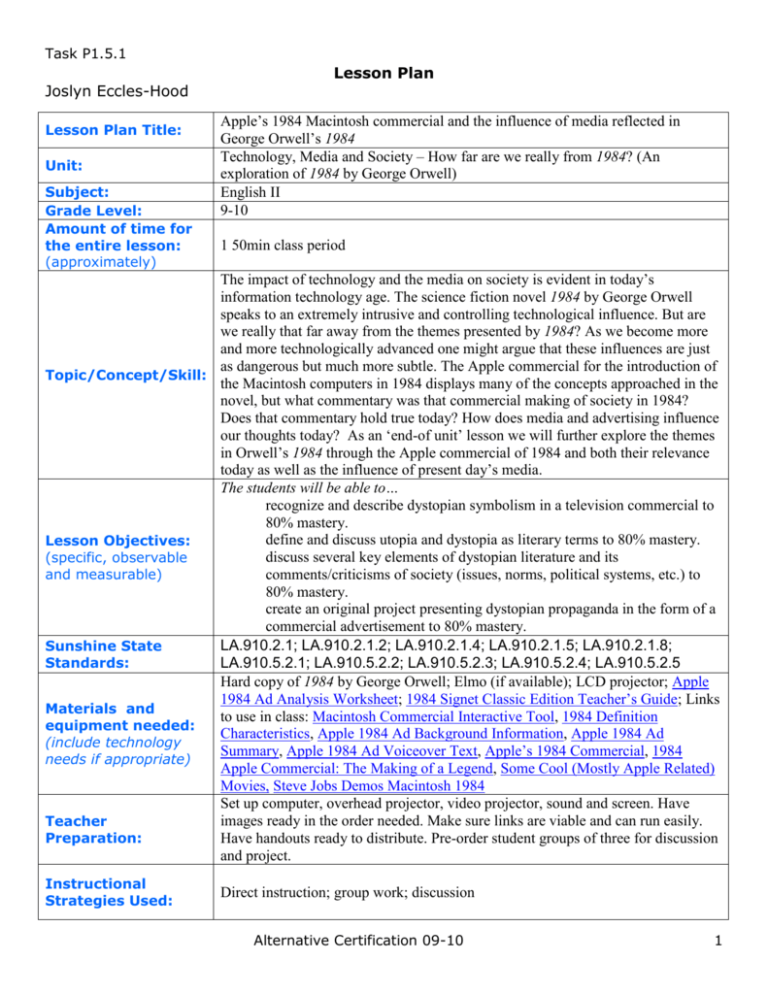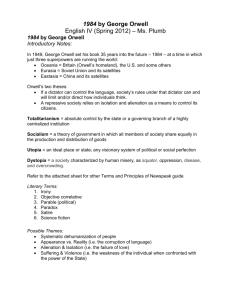Lesson_Plan_technology.doc
advertisement

Task P1.5.1 Lesson Plan Joslyn Eccles-Hood Lesson Plan Title: Unit: Subject: Grade Level: Amount of time for the entire lesson: (approximately) Apple’s 1984 Macintosh commercial and the influence of media reflected in George Orwell’s 1984 Technology, Media and Society – How far are we really from 1984? (An exploration of 1984 by George Orwell) English II 9-10 1 50min class period The impact of technology and the media on society is evident in today’s information technology age. The science fiction novel 1984 by George Orwell speaks to an extremely intrusive and controlling technological influence. But are we really that far away from the themes presented by 1984? As we become more and more technologically advanced one might argue that these influences are just as dangerous but much more subtle. The Apple commercial for the introduction of Topic/Concept/Skill: the Macintosh computers in 1984 displays many of the concepts approached in the novel, but what commentary was that commercial making of society in 1984? Does that commentary hold true today? How does media and advertising influence our thoughts today? As an ‘end-of unit’ lesson we will further explore the themes in Orwell’s 1984 through the Apple commercial of 1984 and both their relevance today as well as the influence of present day’s media. The students will be able to… recognize and describe dystopian symbolism in a television commercial to 80% mastery. define and discuss utopia and dystopia as literary terms to 80% mastery. Lesson Objectives: discuss several key elements of dystopian literature and its (specific, observable and measurable) comments/criticisms of society (issues, norms, political systems, etc.) to 80% mastery. create an original project presenting dystopian propaganda in the form of a commercial advertisement to 80% mastery. LA.910.2.1; LA.910.2.1.2; LA.910.2.1.4; LA.910.2.1.5; LA.910.2.1.8; Sunshine State Standards: LA.910.5.2.1; LA.910.5.2.2; LA.910.5.2.3; LA.910.5.2.4; LA.910.5.2.5 Hard copy of 1984 by George Orwell; Elmo (if available); LCD projector; Apple 1984 Ad Analysis Worksheet; 1984 Signet Classic Edition Teacher’s Guide; Links Materials and to use in class: Macintosh Commercial Interactive Tool, 1984 Definition equipment needed: Characteristics, Apple 1984 Ad Background Information, Apple 1984 Ad (include technology Summary, Apple 1984 Ad Voiceover Text, Apple’s 1984 Commercial, 1984 needs if appropriate) Apple Commercial: The Making of a Legend, Some Cool (Mostly Apple Related) Movies, Steve Jobs Demos Macintosh 1984 Set up computer, overhead projector, video projector, sound and screen. Have images ready in the order needed. Make sure links are viable and can run easily. Teacher Have handouts ready to distribute. Pre-order student groups of three for discussion Preparation: and project. Instructional Strategies Used: Direct instruction; group work; discussion Alternative Certification 09-10 1 Task P1.5.1 Introduction: Anticipatory set, hook, attention grabber, etc. Journal Prompt: Magazine advertisements (on overhead projector or computer) Teacher will introduce a journal prompt to the class: Students will view various magazine images in succession. As students view the images they will describe what each ad is selling, who is the target audience, how each image sells the product in the ad. Teacher will ask students what kinds of media they are accustomed to: How many students watch television/cable/satellite, read magazine/newspapers/books, use the Internet, watch podcasts, listen to music/radio, etc. Teacher will ask students to discuss in groups: 1. How do you obtain information? 2. How do you decide what to buy? Where to buy? What movie to see? Where to eat? What to eat? 3. Do you think media influences any of those choices? 4. What is the difference between a commercial advertisement and a 5. 6. 7. 8. Lesson Procedures: (include activities) PSA? What is propaganda? How do we know when something is propaganda? Give examples. How does advertising influence the way we live? Buy? Vote? The decisions we make every day? What other media influences what we know about society and politics? 9. What are your favorite TV programs? Why? 10. If choices are limited to just a few things is it true choice? Teacher will ask students about what they know of current political and social issues. Teacher will show examples of political and social ads. 11. Students will discuss what they know and don’t know about each issue and why they think they know/don’t know pertinent information: Do these ads make you want to learn more or do you feel you’ve learned enough from these ads? 12. How has the media influenced your knowledge of political and social issues? 13. How do commercial ads influence political/social issues and society’s response? Students will read and discuss the voiceover monologue from the Apple 1984 advertisement: What do you believe the text means? What is your reaction? Students will read and discuss the background information about the Apple 1984 ad: Has this information influenced your understanding of the Alternative Certification 09-10 2 Task P1.5.1 commercial? Assistive Technologies: (as needed) Teacher will show the Apple 1984 commercial. Students will revisit their initial reactions to the voiceover and discuss whether their feelings have changed since they’ve seen the commercial in its entirety. Teacher will briefly review dystopia vs. utopia as well as the definition & characteristics of a dystopia. Teacher will lead a class discussion on the commercial, its meaning and impact. 14. Describe the workers in the ad. Describe the runner. Compare them. 15. What are the dystopian characteristics displayed in the commercial? The dystopian controls displayed? 16. Describe the situation of the protagonist in this commercial. What is the protagonist’s conflict? How is the setting used to show the protagonist’s situation? 17. What is some of the symbolism in the Apple commercial? (e.g. riot gear; circular tunnels; black and white vs. color images; gray uniforms vs. athletic gear; shaved heads; large screen; disembodied “talking” head; hammer; white light from screen; the Apple computer logo; etc.) What do they mean? What does the protagonist’s actions symbolize? 18. What is the comment or criticism of society in the year 1984 displayed in this commercial? How does this relate to George Orwell’s 1984? How does it relate to society now? Teacher will play the Apple commercial again. Teacher will introduce the “1984” Macintosh Commercial Analysis Tool to the class (displayed on LCD projector for the class) Students will complete the “1984” Macintosh Commercial Analysis Tool in their groups. Teacher will give project assignment and criteria: Students will work in groups of three to create their own advertisement/propaganda. Students may create a video, podcast, print ad or radio ad. Students must use visual aids and/or PowerPoint for their presentations. Students will have two weeks to complete the assignment. Presentations must be no less than five minutes and no more than seven minutes long. Students will be expected to ask (audience)/answer (presenters) questions and discuss at the end of each presentation. Computer access modification software/applications for hearing impaired, visually impaired, learning disabled and ESOL students. Visual aids (i.e. digital pictures/video, closed captioning) for the hearing impaired and/or the learning disabled. Audio versions of written material (i.e. mp3, link to audio text, text-tospeech/voice recognition device or software) for the visually impaired and/or learning disabled. Graphic organizer programs (i.e. Inspiration) for learning disabled students and ESOL students. Alternative Certification 09-10 3 Task P1.5.1 Assessment: (based on objectives) Evaluate and Revise Observation of class/group discussions of utopia and dystopia as literary terms and several key elements of dystopian literature and its comments/criticisms of society (issues, norms, political systems, etc.). Observation of class/group deconstruction of a commercial to recognize and describe symbolism. Group project presenting dystopian propaganda in the form of a commercial advertisement. The best way to evaluate much of the students’ work is through informal assessment by observing the students as they work through the information and discuss with their classmates. The project provides a great way to evaluate the students’ use of technology. One possible revision would be to the time allotted to the lesson – it may need a second class period to further delve into and fully comprehend some of the ideas involved. Since this is an ‘end-of-unit’ lesson, many of the terms and concepts would have been discussed earlier and would therefore make the class/group discussions and project a good way to assess comprehension of the novel 1984. Alternative Certification 09-10 4








